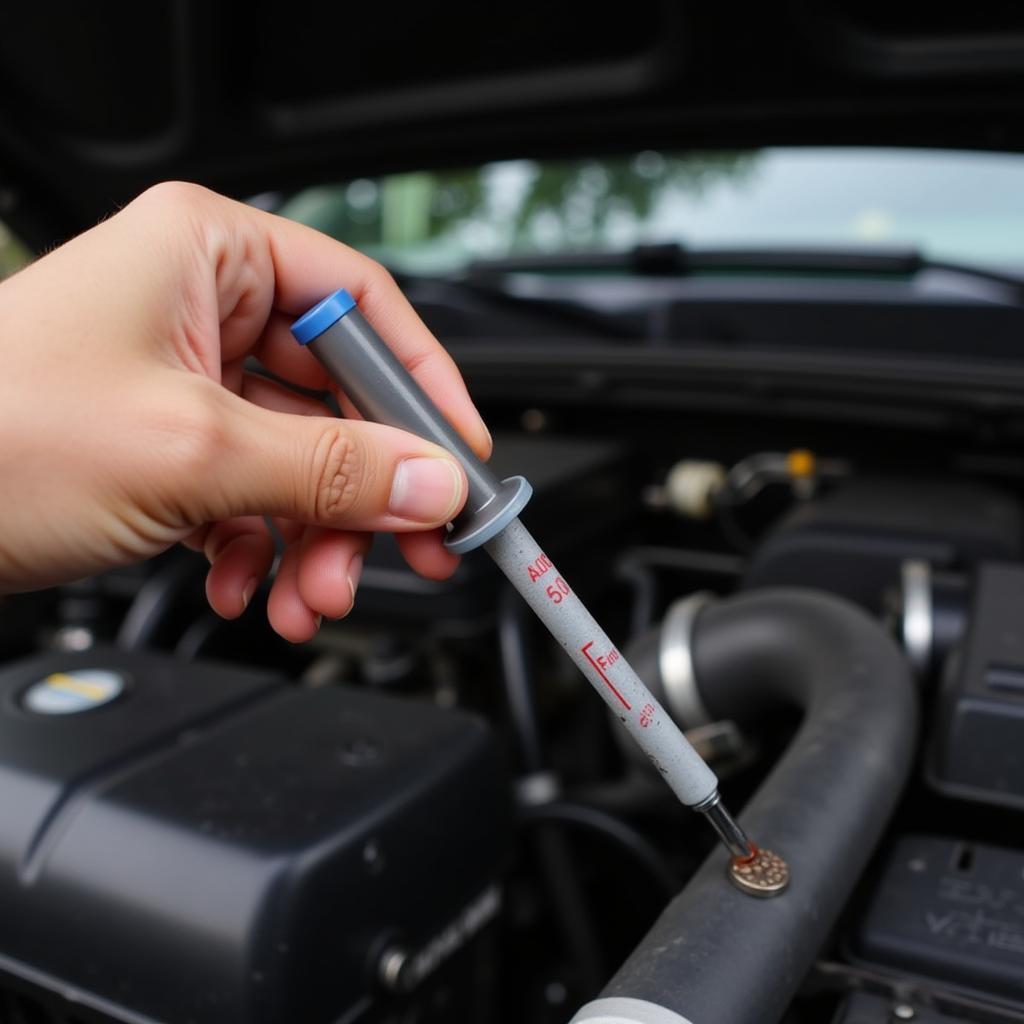A scrape down to the bare metal of your car is more than just a cosmetic issue. It exposes your car’s vulnerable underlayers to the elements, increasing the risk of rust and further damage. Ignoring it isn’t an option. This comprehensive guide will walk you through how to fix a car scrape down to metal, saving you a potentially expensive trip to the body shop.
Similar to [how to fix car body rust](https://autotippro.com/how-to fix-car-body-rust/), addressing a deep scrape promptly is essential. First, assess the damage. How deep and wide is the scrape? A small scrape might be a DIY fix, while larger, more complex damage may require professional attention. Gather your supplies: sandpaper (various grits), primer, automotive paint (matched to your car’s color), clear coat, masking tape, plastic sheeting, rubbing compound, and a polishing cloth. Safety first! Wear gloves and eye protection throughout the process.
Cleaning and Preparing the Damaged Area
Thoroughly clean the scraped area with soap and water, removing any dirt, grease, or debris. This ensures proper adhesion of the primer and paint. Next, use coarse-grit sandpaper (around 180-grit) to smooth out any rough edges and feather the paint around the scrape. This creates a gradual transition between the bare metal and the existing paint, preventing a noticeable ridge after the repair.
What should you do after cleaning the scrape? Once clean, dry the area completely. Any remaining moisture can interfere with the primer and paint, causing bubbling or peeling.
Priming the Bare Metal
Applying primer is crucial. It protects the bare metal from rust and provides a surface for the paint to adhere to. Apply a thin, even coat of automotive primer to the exposed metal and the feathered edges. Allow it to dry completely according to the manufacturer’s instructions. Multiple thin coats are better than one thick coat.
Why is primer so important? Primer acts as a sealant, preventing rust and ensuring the paint adheres properly, leading to a longer-lasting repair.
Applying the Automotive Paint
Once the primer is dry, lightly sand it with fine-grit sandpaper (around 320-grit) to create a smooth surface for the paint. Clean the area again to remove any sanding dust. Now, apply thin, even coats of automotive paint that matches your car’s color. Allow each coat to dry before applying the next. Remember, patience is key to a professional-looking finish.
How many coats of paint should you apply? Typically, 2-3 thin coats of paint are sufficient for good coverage and color match.
how to fix car ding without breaking paint offers helpful insights into minor car repairs. Understanding different repair techniques is beneficial for car owners.
Applying the Clear Coat and Finishing Touches
After the final coat of paint is dry, apply a few coats of clear coat to protect the paint and give it a glossy finish. Once the clear coat is dry, use rubbing compound and a polishing cloth to blend the repaired area with the surrounding paint. This will help to remove any imperfections and create a seamless look.
How long should you wait before applying the clear coat? Allow the paint to dry completely, usually at least 24 hours, before applying the clear coat.
Seeking Professional Help
While minor scrapes can be fixed at home, larger or more complex damage may require the expertise of a professional. places that fix scratches on cars can provide expert assistance for more significant damage. If you’re unsure about tackling the repair yourself, it’s always best to consult a professional. Just like how to fix scratches on car door handle, professional help might be needed depending on the severity of the damage.
Expert Insight from John Smith, Automotive Repair Specialist: “Addressing a scrape down to the metal promptly is crucial. Delaying the repair can lead to rust and further damage, making the repair more complex and costly.”
Conclusion
Fixing a car scrape down to metal might seem daunting, but with the right approach and a little patience, you can restore your car’s appearance and protect it from further damage. Remember to prioritize safety and cleanliness throughout the process. For more tips and advice on car maintenance and repair, don’t hesitate to connect with us at AutoTipPro. You can reach us at +1 (641) 206-8880 or visit our office at 500 N St Mary’s St, San Antonio, TX 78205, United States.
how to fix a frozen car d is another useful resource for car owners facing common winter car troubles.






Leave a Reply